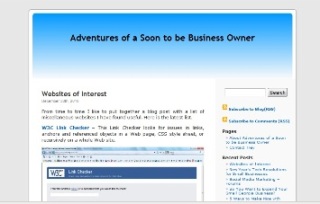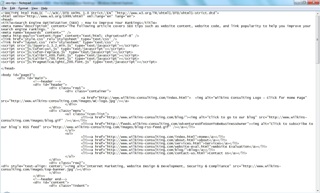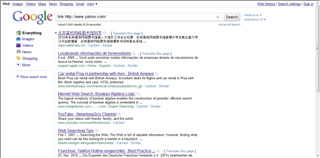Search Engine Optimization (SEO) - How to Improve Your Rankings
Main Articles Page by Trey WilkinsSearch Engine Optimization is quite simply optimizing your website to achieve better results in the natural search results. Companies like mine use what are known as SEO White Hat methods for optimizing websites which means that we use techniques that search engines recommend as part of website design. These techniques tend to be quite involved and in some cases may take time to achieve top ranking results with the knowledge that once you achieve the high rankings they should last for long periods of time.
Search engines are constantly changing their algorithms which means that we must stay on top of these changes in addition to employing many different techniques that can be quite involved and time consuming to help you achieve the very top rankings, but there are actually three time-tested methods that you can use today to help improve your rankings in the search engines. In this article I will be discussing website content, website code, and link popularity
First a Little SEO History
Although the terms are not used as much today, SEO techniques can be broken down into two categories - whitehat and blackhat. Whitehat refers to using known search engine guidelines to increase your rankings, recognizing that although this method will take longer, it will also result in long term improved search engine results. Blackhats use tricks and backdoor techniques to improve search engine rankings very quickly with the understanding that the website could lose those rankings and even be banned at some point if the search engines detect the "tricks."
I will be discussing whitehat SEO website coding techniques only, but to give you an idea, one of the tricks in the early days was to use hidden text which was quite simply using the same color for the text as the background. So if you were discussing a particular topic, such as widgets, on your web page and you wanted to improve your rankings, you would have listed the word widgets multiple times but using the same color as the background. The redundant listing of widgets would have been invisible to users browsing your site, but the search engine crawlers (spiders) would have picked up the listings. As I said I will only be discussing whitehat techniques, and I recommend that you stay away from the blackhat shortcuts and instead work for the long term gains.
Website content
This is probably the easiest method, but it is often overlooked. Many times a company will put up what we call a brochure website with a company overview of products and services, and then they will hardly touch it again for years...the old build it, and they will come adage. Unless you are in a very small niche category, you will slowly fade away into the results where no one will ever find you.
Instead you need to follow another great adage...content is king. Your content needs to be deep - tons of information covering not only the aspects of your company but of your industry along with tips and helpful knowledge that people will seek out and find easy to read and understand. In addition it needs to be fresh - meaning you are constantly changing and updating your content. But to be clear - do not write for the search engines: write for your prospective clients. Give them information that is useful and provide helpful information that you consider an add-on to your products and/or services. It is really just that easy, and here are some simple ways you can provide this type of content.

- Blogs such as mine where you can provide news,advice, tips, recommendations, industry updates, etc.
- Newsletter and press releases
- Place unique content on your social media marketing sites, and link them together - keep it more informational than promotional. Remember you are building relationships
- Provide whitepapers, resources, education, and information
- When you update and/or add new products/services, then make sure you update your site
Website code
Website code is the text behind the scenes that the search engines views and crawls. In a nutshell it is really quite simple: correct code will help improve your website rankings and more importantly it will give people viewing your website a more user friendly experience.
An easy way for you to get started in monitoring your website is to sign up and validate it through Google Webmaster Tools. Using Google Webmaster Tools will allow you to easily check for errors on your website, such as broken links or duplicate title tags.
Examples of using "clean" or correct code to improve your search engine rankings

- As mentioned in my note about signing up for Google Webmaster tools, you want to check for broken links, duplicate title tags, or duplicate content. For example with duplicate title tags, you may inadvertently copy of over the same title tag from one page to another.
- Meta tags - Title tags and description tags. Meta tags tell search engines the content that should exist on each web page. As I discussed in the first example, you do not want to have duplicates, but you also want the tags to match the content on the page only. For example if you are discussing a review of laptop computers, then the title tag should say "Review of Laptop Computers."
- Alt image tags - If you have clickable images on your page, you want to name them with an alt image tag so that when a user scrolls over an image, the alt image tag provides a description of the image for the search engine spider in addition to the user.
- Header tags - Header tags are used to define the html headings. Although Header tags will not help you directly from an SEO standpoint, it is still considered clean code. So once again if you are discussing a review of laptop computers, then Review of Laptop Computers would be the first heading on your webpage, and you would use an H1 tag. Next you might break your discussion down into different brands, and for each brand heading you would use an H2 tag. This gives the search engines, as well as the user, a hierarchy of what is the most important content on a particular webpage.
- Duplicate content - Remember my example of the early blackhat trick of using hidden text. This is a simple example of duplicate content, but a larger problem may exist just with the setup of your website. Search engines consider http://wilkins-consulting.com and http://www.wilkins- consulting.com to be two different websites so some search engines might consider this duplicate content. On a side-note you may also have the issue of splitting your website's link popularity which we will discuss in Part III. The solution is to permanently 301 redirect your secondary url to your primary url (ex. non-www to www), and depending on the type of server you are using to host your site, there are different ways to do this which I will discuss in future blog postings. You can also validate both website types in Google Webmaster Tools, and instruct Google on which website is your primary site.
Increase your link popularity
The higher numbers of quality links you have pointing to your website will increase what is known as site authority, and this will be another factor in increasing your site rankings in the search engines. Before I discuss some easy steps to increasing your rankings, let's discuss what will not work - link swapping. Just as an inbound link will increase your site authority, an outbound link will decrease the equation and link exchanges are largely ignored by search engines anyway. So what are some easy ways to increase the links pointing to your site.

- Good content - Provide interesting and helpful content, and people will naturally link back to your site because of the value your site provides. This is the strongest way to increase your site rankings in the search engines, and it should also be the goal of every website owner, but it also takes time so let's talk about some quicker methods.
- Free website directories - There are quite a few free directories that you should submit your site to such as www.dmoz.org, Jayde.com, and SoMuch.com. Just find the right category for your site, and follow the site submission guidelines.
- Paid website directories - There are also quite a few excellent paid directories such as the Yahoo directory, Best of the Web, Joe Ant, and Business.com. Once again find the correct category for your site and follow the submission guidelines.
- Additional directories - You should also look for local city directories where your company is located, and if you have a blog here is a page with links to blog directories.
- Check your competitor's links - Find the sites that are linking to your competitor's site, and if it makes sense (such as a site that links to companies in a certain business category), then send an email to the site owner requesting a link to your site as well. There is no need to offer a link swap. Keep it short, be polite, and request a link to your site explaining what your company has to offer. In order to find out what sites are linking to your competitor's site, just go to Google, and put in the following code: link:http://www.yourcompetitor.com/.
It takes time to build links to your site, but combine your increased links along with good, fresh website content and correct website code, and you will be well on your way to increasing your website rankings in the search engines. If you have any questions, please do not hesitate to contact me today.
Share This Article






